
4 minute read
Fil-Can artist tapped to restore more images at St. Malo Shrine
by Lucille Nolasco-Garrido

Advertisement
The annual pilgrimage to the Shrine and Grotto of Notre Dame de Lourdes in St. Malo, Manitoba was held on Sunday, August 13.
Attendees may have noticed the newly restored and repainted collection of outdoor statues of the Shrine. These religious statues were cleaned and repaired by Filipino Canadian artist John Millar, who was previously commissioned to recreate a reclining image of St. Bernadette, which was stolen from the Shrine in June of last year.

Pilipino Express caught up with Millar to find out more about his latest projects for St. Malo.
PE: After you recreated a new image for St. Bernadette, tell us about your new projects for the St. Malo Shrine.
JM: After the installation of the replica of St. Bernadette’s body in the chapel, the board committee of St. Malo Shrine and Grotto said they were so impressed with my work that they hired me to do repairs and painting on all the statues that fell into disrepair at the shrine.
The outdoor concrete statues have developed cracks, chips, and other damage over the years. A couple years ago someone attempted to paint the skin and hair on the three statues at the Crucifixion Scene but left them unfinished. I prioritized the cement repairs on the statues that were structurally compromised or had other aesthetic defects, like a broken hand, missing toe, chipped nose, etc. I then proceeded to paint the statues in full colours to bring them to life; the Crucified Jesus, Mother Mary, and St. John at the foot of the cross, La Pieta (Mary with the Dead Christ on her lap), and Jesus in the tomb. Those statues were finished and took a total of three weeks, but the work is still ongoing. I will have to return in September to complete everything that is planned.

PE: What would be the most noticeable for the visitors to the Shrine?
JM: Visitors to the shrine will have noticed that the old statue of the Crucified Jesus is back on the cross. It needed repairs, which is why it was taken down around two years ago, but I was able to fix it and paint it in colour, which is why it is now back in place. The new Crucified Jesus statue that was donated by the Manitoba Métis Federation last year (presented during the pilgrimage in August 2022) also needed repairs due to damages during shipping, which I was able to complete as well, but it is now in a storage facility because the material is not suitable for Manitoba weather. The committee was very happy to have the original Crucified Jesus statue restored.
PE: What goes on through your mind while during the restoration work?
JM: Long hours passed while I worked up to 11 hours a day, so that gave me plenty of time for quiet reflection on these religious stories and narratives and how I relate to them on a personal level.
I think about how I can integrate the lessons that are being taught and how they can help me grow spiritually and to develop a sense of integrity. Experiences like this allow me to contemplate that God is present not just in what we use to represent him, but even in his own creation in the natural environment. God speaks to us every day in the echo of his creation.
PE: What does all this mean to you?
JM: My art practice has always been meaningful for me, whether or not I’m working on something considered religious. Art is a form of expressing your spirit, but also a form of therapy. It has the potential to heal not only yourself but also the people around you too. The most rewarding part of doing my job is the joy and healing that it brings to people. The money is a benefit, but the reactions and approval of the client or community is forever priceless. I believe that doing something as simple as artistic work is powerful and uplifting. We are given talents and skills to share, to direct us on our path of purpose and destiny. Sometimes it only takes one small spark to ignite a big change in someone else’s life, and for me that is art.
PE: For you personally, how important is restoring and/or fixing holy images for the faithful community?
JM: The restoration work for religious statues is never just about restoring the physical statues, but restoring the sense of faith and hope in people that these statues bring or remind everyone of. Painting them in colour instead of just plain white helps with the visualization of what these statues represent; they are anchors of faith and reminders of historical events that the faithful believe to have happened. There were visitors at the shrine every day that I was working, and I had many compliments from people who were pleased to see them come to life in colour instead of just plain white. I try to achieve a sense of realism in my work because to many, these are not just statues. They are representation of those we believed once lived on earth, just like photographs to remind people.
PE: Anything else you would like to add or impart to our readers?
JM: I appreciate everyone’s acknowledgement and compliments about my work, but what I would really like the most for people to express their gratitude is to donate to this special place so that it does not fall into disrepair at any point in the future. There are always hefty maintenance and renovation costs, especially because the shrine has plans for building a proper washroom facility in the next year or two.
E-transfer donations can be sent to “secretary@stmaloparish. ca” with note “for grotto renovations”, or cheques can be sent and made payable to the parish with a note “for grotto renovations.” Any amount is immensely appreciated. An advanced thank you from myself and the shrine for your generosity.
St. Malo Parish Box 69 St. Malo, MB R0A 1T0














